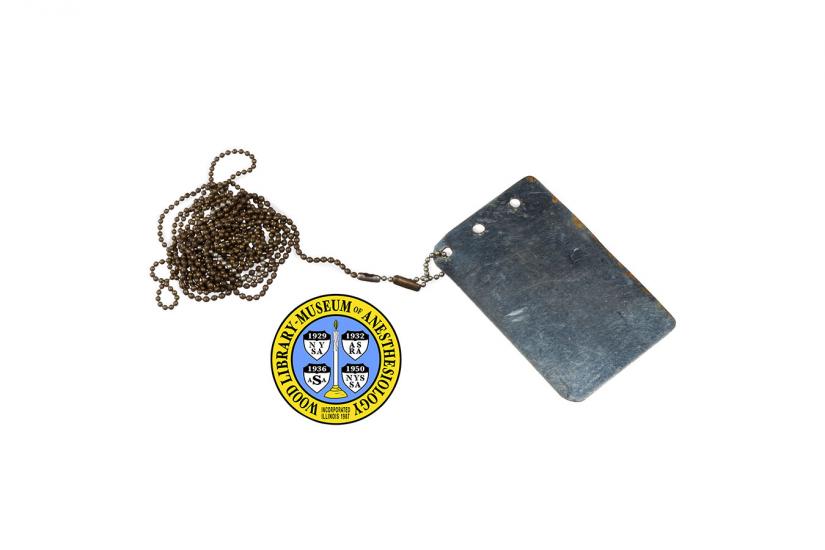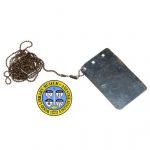Grounding Device
Ether (clinically introduced in 1846), ethylene (clinically introduced in 1923) and cyclopropane (clinically introduced in 1932) are all anesthetics that can explode in the presence of a spark or an open flame. Many precautions were taken to prevent this, including the use of electrical grounding devices to limit the buildup of static electricity. Grounding chains were built into some anesthesia machines, and some anesthesiologists also carried their own safety devices. The grounding plate and chain seen here belonged to Dr. Paul M. Wood (1894-1963), whose entire career was spent working with flammable anesthetics. Another, more complex grounding device was the Horton Intercoupler. National safety codes also strove to prevent fires and explosions. New, non-explosive agents were introduced in the 1950s, and by the 1970s flammable anesthetics were banned from use in U. S. hospitals.
Catalog Record: Grounding Device
Access Key: aknu
Accession No.: 298
Title: [Grounding plate and chain.]
Title variation: Alt Title
Title: Grounding device.
Title variation: Alt Title
Title: Drag chain.
Title variation: Alt Title
Title: Wood’s intercoupler.
Publisher: [Place of manufacture not indicated] : [Name of manufacture not indicated];
[1928-1950].
Physical Descript: 1 grounding device : metals ; 11.5 x 7 x .5 cm.
Subject: Operating Rooms – safety measures.
Subject: Explosions – prevention and control.
Subject: Health Facilities – fires and fire prevention.
Note Type: General
Notes: The date range for the possible year of manufacture is based on the dates of
literature in which the terms “grounding plate” and “drag chain” occur with
relative frequency. The date range could change if documentation indicates it
should be corrected.
Note Type: General
Notes: Name based on the WLM descriptive name for the device.
Note Type: With
Notes: Canvas pouch stored elsewhere.
Note Type: Citation
Notes: McCurdie MH. Anesthesia explosion hazards: some methods of control. Am J Nurs
1941;41(3):261-264.
Note Type: Citation
Notes: MacDonald AG. A short history of fires and explosions caused by anaesthetic
agents. Br J Anaesth. 1994;72(6):710-722.
Note Type: Physical Description
Notes: One metal plate with beaded metal chain; The approximate general measurements
11.5 x 7 x .5 are based on the one possibility of the space occupied by both
the plate and chain if laying flat on display; The metal plate measures
approximately 9.5 x 6 x .5 cm, and the metal chain measures approximately 220
cm in length; three small homes puncture the top edge of the plate and the
chain is connected through the left most hole; The only marking is an
accession mark, “298”.
Note Type: Reproduction
Notes: Photographed by Mr. Steve Donisch, June 10, 2013.
Note Type: Historical
Notes: Metal plates and chains like this were used from about 1930 to the 1950s to
prevent electrostatic sparks from discharging in operating rooms where
combustible anesthetics like ether, ethylene and cyclopropane were used. This
device connected and equalized the electrostatic charge of the objects to
which it was connected, such as an anesthesia machine, and the operating room
floor.
Sparks from static electricity were not the only source of ignition in the
operating room but they were an important one, and a number of safety
practices were employed to prevent them. Other precautions included chains to
connect the patient, anesthesia machine and anesthesiologist, special
flooring, special lighting, conductive footwear, and conductive wheels on
anesthesia machines. For another example see the Horton Intercoupler.
Elaborate electrostatic precautions decreased in importance after the
introduction of nonflammable anesthetics such as Halothane.
This grounding plate and chain was owned by anesthesiologist Paul M. Wood, M.
D. (1894-1963).
Note Type: Publication
Notes: Burkle CM, Zepeda FA, Bacon DR, Rose SH. A historical perspective on use of
the laryngoscope as a tool in anesthesiology. Anesthesiology.
2004;100(4):1003-1006.
Note Type: Publication
Notes: Henderson Y. The hazard of explosion of anesthetics: report of the Committee
on Anesthesia Accidents. JAMA. May 10, 1930;94(19):1491-1498.
Note Type: Exhibition
Notes: Chosen for the WLM website (noted November 11, 2013).


